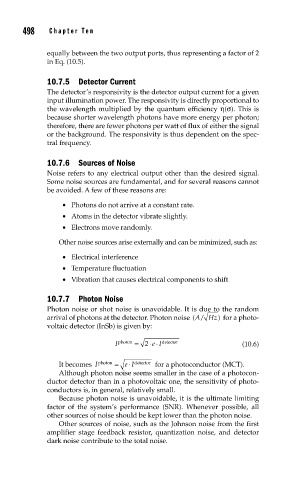Page 545 - Sensors and Control Systems in Manufacturing
P. 545
498
Cha p te r
T e n
equally between the two output ports, thus representing a factor of 2
in Eq. (10.5).
10.7.5 Detector Current
The detector’s responsivity is the detector output current for a given
input illumination power. The responsivity is directly proportional to
the wavelength multiplied by the quantum efficiency η(σ). This is
because shorter wavelength photons have more energy per photon;
therefore, there are fewer photons per watt of flux of either the signal
or the background. The responsivity is thus dependent on the spec-
tral frequency.
10.7.6 Sources of Noise
Noise refers to any electrical output other than the desired signal.
Some noise sources are fundamental, and for several reasons cannot
be avoided. A few of these reasons are:
• Photons do not arrive at a constant rate.
• Atoms in the detector vibrate slightly.
• Electrons move randomly.
Other noise sources arise externally and can be minimized, such as:
• Electrical interference
• Temperature fluctuation
• Vibration that causes electrical components to shift
10.7.7 Photon Noise
Photon noise or shot noise is unavoidable. It is due to the random
arrival of photons at the detector. Photon noise (/A Hz ) for a photo-
voltaic detector (InSb) is given by:
⋅
I photon = 2 ⋅ e I detector (10.6)
⋅
It becomes I photon = e I detector for a photoconductor (MCT).
Although photon noise seems smaller in the case of a photocon-
ductor detector than in a photovoltaic one, the sensitivity of photo-
conductors is, in general, relatively small.
Because photon noise is unavoidable, it is the ultimate limiting
factor of the system’s performance (SNR). Whenever possible, all
other sources of noise should be kept lower than the photon noise.
Other sources of noise, such as the Johnson noise from the first
amplifier stage feedback resistor, quantization noise, and detector
dark noise contribute to the total noise.

